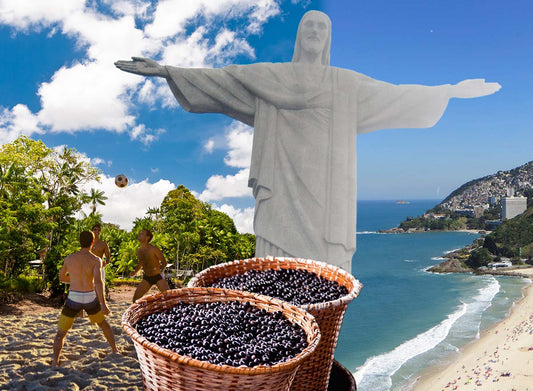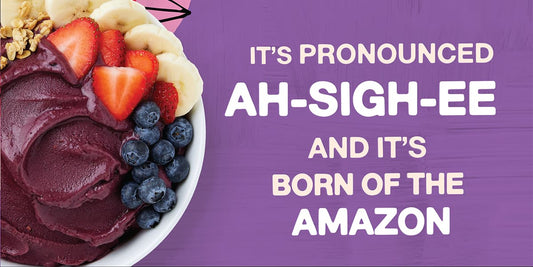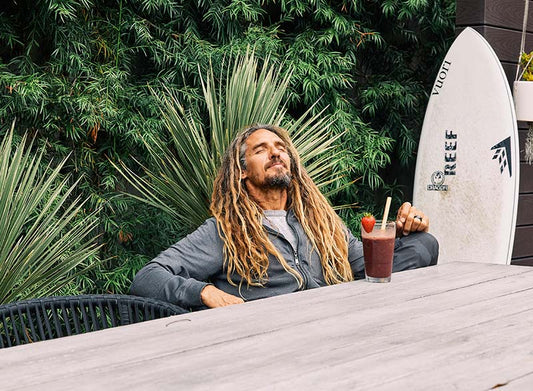Maybe you’ve seen it in your frozen food aisle. Maybe your favorite foodie you follow on Instagram is raving about its nutritional benefits. Either way, there’s more to the fresh Açaí berry than meets the eye (or tastebuds).
If you love an Açaí smoothie, it’s only right to ask where Açaí comes from and the ins and outs of Açaí, including if Açaí is keto, if that is your forte.
While still rising in popularity in America, this Brazilian fresh fruit berry has a rich and complex legacy intertwined with the indigenous cultures of South America. To get a taste of this plant’s fascinating history, keep reading to learn the full story, including:
- Açaí’s origins
- Açaí’s native mythology
- Açaí harvesting practices
- Tasty treats made with Açaí
The Origins of Açaí
When you order an Açaí bowl and take a bite of the creamy, stunningly purple blend, you might be wondering what Açaí is made of. This takes us back to the centuries of tradition, history, and culture of Açaí—all of which led this nutrient-dense berry to you.
To understand Açaí’s roots, let’s dive into the biological, geographical, and cultural origins of this plant.
The Açaí Plant
The fresh Açaí berry is just one part of this special plant. Unlike strawberries or raspberries, Açaí fruit actually comes from trees instead of bushes. Tall and thin, you can recognize these Açaí palm trees by their distinguishable characteristics:
- Height of 15 to 30 meters
- Small beige-purple flowers
- Ribbon-like leaves up to 4 meters long
- Berries hanging in dense clusters (green to purple)
- Ridged gray-brown trunks
On average per year, each Açaí tree produces 20kg of its precious fresh fruit. Indigenous tribes have also traditionally harvested Açaí palm hearts, leaves, and bark, utilizing the entire palm tree for food and medicinal purposes. From root to leaf tip, it’s one of the most important plants for Amazonian culture.
Location
Where do Açaí berries come from? The top answer here is one special ecosystem—the fertile Amazon River basin.
Humid, hot, and incredibly diverse, the Amazon River basin is an ecological paradise so it’s no surprise that Açaí palm trees thrive in the basin’s tropical climate. This fertile area stretches across upper South America, including the countries of:
- Bolivia
- Brazil
- Ecuador
- Colombia
- Guyana
- Peru
- Suriname
What’s one spot where Açaí trees truly thrive? The high majority of harvested Açaí berries come from Pará, a Brazilian state deep within the basin. This area produces over 90% of Brazil’s entire Açaí fruit exports.
Culture & History
The Açaí tree is more than just a crop—it’s a cultural fixture among Amazonian tribes and villages.
For centuries, the Açaí tree was only consumed by indigenous communities along the Amazon River basin. Tribes like the Shuar, the Awá, and the Yanomami used Açaí trees for medicinal and culinary purposes, creating a rich tradition of their use. In particular, they mashed and fermented the Açaí berry into a medicinal wine used for impotency and immunity.
Once modern industrialization reached the Amazon basin, Açaí berries began traveling beyond its borders. From the 1970s onwards, the fruit’s reach grew with every decade:
- 1970s – As modern farming began disrupting the Amazon, the Ribeirinhos began relocating to northern Brazil cities like Macapá and Belém. With them, they brought the culture of eating Açaí fruit with them. The Ribeirinhos then sold the Açaí fruit pulp out of roadside stands, popularizing its consumption in Brazil’s urban populations.
- 1980s – A decade later, the Gracie family expanded the Açaí fruit to southern Brazil cities like São Paulo and Rio. The Gracies taught jiu jitsu, a Japanese martial art practice popular in Brazil. As part of their training, they recommended that students eat Açaí fruit pulp and frozen Açaí for its energy and nutrients. Water sport athletes on the nearby Ipanema and Copacabana beaches began adding the fruit to their sports diet as well.
-
2000s – In the early 2000s, Açaí began its ascent to North American markets. Entrepreneurs, like Ryan Black, the founder and CEO of SAMBAZON, took an interest in this local fruit, eager to take it back home to the United States. Working with local harvesters, our team preserves the historic and ecological legacy of the Açaí tree while sharing its amazing benefits with a wider audience.

Açaí in Myth & Legend
The roots of the Açaí fruit run deeper than Amazonian soil. A mythological fixture, Açaí trees hold a treasured spot in tribal lore—specifically, the captivating tale of Princess Iaça.
Years and years ago, a Brazilian tribal chief ordered the murder of all newborns during a famine. This decree even included the baby of his daughter, Princess Iaça. For months, she grieved her child’s death inside her hut.
Until one night, she heard a mysterious sound—the cries of a baby, calling for her.
Iaça ran under the full moon in search of this baby, only to find a majestic palm tree. Yet when she looked up, she saw no infant in sight. Devastated, she laid to die underneath the tree. When the chief found his daughter’s body, he decreed the Açaí tree sacred and ordered the tribe to harvest the berries, conquering the famine and lifting the newborn ban. The miraculous tree was named in honor of his loving daughter—reversing “Iaça” to “Açaí”.
Why tell this story? We believe the culture of the Amazonian people deserves preservation as much as the Açaí tree itself.
Açaí Kitchen Inspiration
Now that you’ve learned a bit more about where Açaí comes from, it’s time to put this nutrient-packed berry to good use in your kitchen—and your tummy. Thanks to its versatile flavor profile, you’ll be able to infuse it into a number of recipes—from cocktails to desserts.
Grab an apron and get started with these simple Açaí recipes:
-
Açaí Banana Smoothie - One of our favorite fruits to incorporate with Açaí is bananas, but if you want to take it a step further for a sweeter taste, check out our Banana Date Shake Recipe! One Açaí Original Blend Superfruit pack, chopped dates, oat milk, date syrup, half of a frozen banana and powdered peanut butter is all it takes to create this mouth-watering smoothie. If you’re also looking for a tropical smoothie, try out our Clean & Green Smoothie Recipe, and be sure to check out our blog on Pitaya vs Açaí to learn about the differences of these fruits.
Expert tip: Learn how to store smoothies in our latest blog to enjoy this recipe for the next few days!
-
Hot chocolate Açaí bowl – Gather round, chocolate lovers. This unique spin on a classic Açaí bowl will have your mouth watering before you even begin to blend. Mix an Açaí Pure Unsweetened Superfruit Pack, cacao powder, oats, plant-based milk, and a few more tasty treats together for a combo that’s just as cozy as it is nutritious.
- Berry bourbon lemonade Açaí cocktail – For a unique libation that’s sure to be a hit at your next dinner party, don’t miss the berry bourbon lemonade cocktail with Açaí. Start with Açaí Energy Drink, add bourbon, blackberry simple syrup, and a dash of fresh lemon juice. Combine, shake, and serve over frozen berries. Finish it off with a mint garnish.
SAMBAZON: Preserving Açaí’s Legacy
Açaí is more than a tasty and nutritious snack. It’s a living symbol of indigenous culture, tradition, and mythology. That’s why it’s important to choose Fair Trade Açaí producers that support its native growers and habitat—like SAMBAZON.
There’s more to SAMBAZON than just delicious frozen Açaí bowls. Between eco-friendly harvesting and community outreach, we aim to uplift the world that creates this incredible fruit.
Explore our conscious consumption efforts today, and join our movement towards a more sustainable and respectful way to enjoy Açaí.
Sources:
Britannica. Açaí. https://www.britannica.com/plant/Açaí
EcoCert. What is the purpose of Fair for Life certification? https://www.ecocert.com/en/certification-detail/fair-trade-fair-for-life
Forest News. Açaí: could the wonder fruit also be wonderful for forests? https://forestsnews.cifor.org/10700/Açaí-could-the-wonder-fruit-also-be-wonderful-for-forests?fnl=en
Global Environment Facility. Integrated and Sustainable Management of Transboundary Water Resources in the Amazon River Basin Considering Climate Variability and Climate Change. https://www.thegef.org/projects-operations/projects/2364
Healthline. 5 Impressive Health Benefits of Açaí Berries. https://www.healthline.com/nutrition/benefits-of-Açaí-berries
IB Times. Açaí – What is it and Where Does it Come From? https://www.ibtimes.com/açaí-what-it-where-does-it-come-183593
NCBI. Effects of Açai (Euterpe oleracea Mart.) berry preparation on metabolic parameters in a healthy overweight population: a pilot study. https://pubmed.ncbi.nlm.nih.gov/21569436/
Statista. Açaí berry crop production in Brazil in 2019, by state. https://www.statista.com/statistics/1069905/production-açaí-brazil-state/
Survival International. Brazilian Indians. https://www.survivalinternational.org/tribes/brazilian
The New Yorker. Strange Fruit. https://www.newyorker.com/magazine/2011/05/30/strange-fruit-john-colapinto






Comments
(0 Comments)Please note, comments need to be approved before they are published.